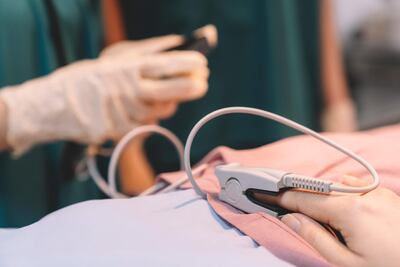Read also: Abu Dhabi approves Covid-19 facial scanners after positive trial
Facial scanners that can detect signs of Covid-19 have been introduced in Abu Dhabi.
The device comprises a camera and a phone application developed by a research lab based in the capital.
Security staff in malls were already using the system on Monday. It looks for signs that a person could have Covid-19.
So how does it work?
Scanning faces for signs of Covid-19
The facial scanner now being used was developed by the EDE Research Institute Abu Dhabi.
It detects a possible Covid-19 infection by measuring electromagnetic waves, “which change when the RNA [ribonucleic acid] particles of the virus are present in the person’s body”.
RNA typically acts as a messenger carrying instructions from DNA.
How do the scanners work?
A reader is placed within five metres of the people set to be scanned.
Within seconds, the device analyses each face, and sends a message to the smart phone held by the operator.
Green means the subject has tested negative, a red reading indicates they have tested positive.
The EDE scanner is used alongside other devices, including thermal scanners.
Where will the scanners be installed?
The technology will be used at various shopping malls and public places in Abu Dhabi, some residential areas, and all land and air entry points starting from Monday.
How do we know they work?
The introduction of EDE scanners comes after a trial of the technology in Ghantoot, Yas Island and Mussaffah, Abu Dhabi Media Office said on Sunday.
It said 20,000 people had been tested in the pilot and the results showed more than “90 per cent sensitivity”.
What happens if the scanner finds someone positive?
If the scanner identifies a person as being potentially infected with Covid-19, they will not be permitted to pass, and they must take a PCR test within 24 hours.
How a heart scan could detect Covid-19
Mayo Clinic in the US recently published research indicating that Covid-19 creates subtle electrical changes in the heart, which can be detected by an AI-enabled electrocardiogram (EKG).
This means an EKG could potentially be used as a rapid, reliable screening test.
The research was garnered through an international effort, and data was pooled from four continents and 14 countries.
The AI-enhanced EKG was able to accurately detect a negative Covid-19 infection in 91 per cent of people.
"This study demonstrates the presence of a biological signal in the EKG consistent with Covid-19 infection, but it included many ill patients," said Dr Paul Friedman, chairman of the clinic's Department of Cardiovascular Medicine and senior author of the study.
"While it is a hopeful signal, we must prospectively test this in asymptomatic people using smartphone-based electrodes to confirm that it can be practically used in the fight against the pandemic," said Dr Friedman. "Studies are under way now to address that question."
Other Covid-19 scanning technology
Several other electronic devices designed to detect Covid-19 have been developed around the world.
Some scanners are installed as smartphone apps and they detect a user's heart rate, oxygen level, respiration rate and even stress level within 45 seconds.
The app analyses the skin of the person's face, and using a mixture of light, artificial intelligence and an algorithm, it can read what is going on in the blood under the skin.
If you have ever had your oxygen levels checked in a hospital, you might remember having a clip with a red light placed in your finger, called an oximeter.
The app is doing the same thing, optically, through the camera on the smart phone. The technique is known as photoplethysmography (PPG).
Temperature and oxygen levels are important because people who are suffering from Covid-19 frequently have a fever, and their oxygenation levels can be lower, because coronavirus affects the respiratory system.
Normal oxygen levels are 90 or above, and become a concern when they drop below this level.









